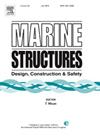Wave scattering by an elastic plate in a viscous fluid of finite depth
IF 5.1
2区 工程技术
Q1 ENGINEERING, CIVIL
引用次数: 0
Abstract
This work examines a two-dimensional wave scattering problem in a viscous, incompressible fluid of finite depth over an impermeable bottom by a semi-infinite and finite floating elastic plate. Weakly viscous potential theory is utilized to frame the problem using the velocity potential and stream function. The paper addresses three main objectives: first, it analyzes the behavior of the distorted positive real root of the dispersion relation in both the water region and the region covered by the plate; second, the boundary value problem is solved separately for both semi-infinite and finite elastic plates using the matched eigenfunction expansion method; third, the impact of different parameters on various hydrodynamic coefficients is examined through several numerical plots. We find that the viscosity affects the low-frequency waves more than the high-frequency ones in the plane progressive wave analysis. Further, it seems that the effect of viscosity increases with a decreasing water depth. From the wave scattering problem with varying viscosity, it is noted that, at low viscosity levels, the wave energy absorption by the medium is minimal, resulting in a reflection coefficient close to 1. With an increase in the viscosity to moderate levels, more wave energy is dissipated due to viscous effects, reducing the reflection coefficient to nearly 0.
弹性板在有限深度粘性流体中的波散射
本文研究了半无限和有限浮动弹性板在不透水底部上有限深度的粘性不可压缩流体中的二维波散射问题。利用弱粘性势理论,利用速度势和流函数来构造问题。本文主要有三个目标:首先,分析了色散关系的畸变正实根在水区和被板覆盖的区域的行为;其次,采用匹配特征函数展开法分别求解了半无限弹性板和有限弹性板的边值问题;第三,通过若干数值图考察了不同参数对各水动力系数的影响。在平面进行波分析中,我们发现黏度对低频波的影响大于对高频波的影响。此外,粘度的影响似乎随着水深的减小而增加。从变黏度的波散射问题可以看出,在低黏度时,介质对波能的吸收最小,反射系数接近于1。当粘度增加到中等水平时,由于粘性效应,更多的波能被耗散,反射系数降低到接近0。
本文章由计算机程序翻译,如有差异,请以英文原文为准。
求助全文
约1分钟内获得全文
求助全文
来源期刊

Marine Structures
工程技术-工程:海洋
CiteScore
8.70
自引率
7.70%
发文量
157
审稿时长
6.4 months
期刊介绍:
This journal aims to provide a medium for presentation and discussion of the latest developments in research, design, fabrication and in-service experience relating to marine structures, i.e., all structures of steel, concrete, light alloy or composite construction having an interface with the sea, including ships, fixed and mobile offshore platforms, submarine and submersibles, pipelines, subsea systems for shallow and deep ocean operations and coastal structures such as piers.
 求助内容:
求助内容: 应助结果提醒方式:
应助结果提醒方式:


